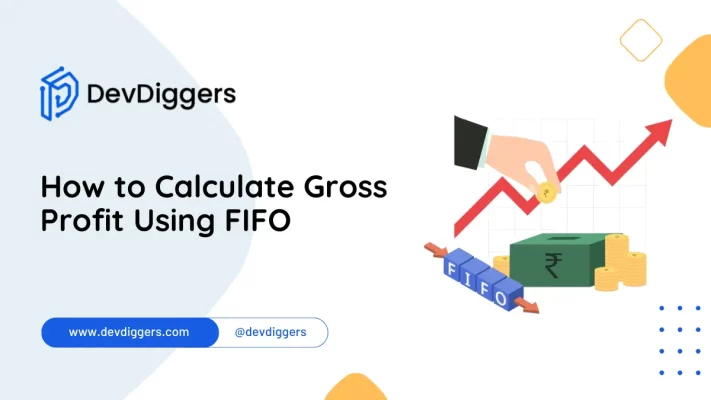How to Calculate Gross Profit Using FIFO

Understanding how to calculate Gross Profit using FIFO is essential for businesses seeking to optimize their financial management strategies.
Gross profit is a fundamental measure of profitability, and the FIFO (First-In, First-Out) method offers a structured approach to inventory valuation.
By prioritizing the sale of oldest inventory items first, FIFO provides insights into the cost of goods sold (COGS) and helps businesses make informed decisions about pricing, inventory management, and overall financial health.
In this blog post, we’ll explore the significance and practical applications of calculating gross profit using the FIFO method.
We will offer step-by-step guidance to empower businesses in their financial analysis and strategic planning.
Whether you’re a seasoned entrepreneur or a novice navigating the complexities of commerce, mastering FIFO can enhance profitability and sustainable growth.
Table of Contents
What is Gross Profit?

Gross profit, especially when considering how to calculate gross profit using FIFO, is a financial metric that represents the difference between a company’s revenue from sales and the cost of goods sold (COGS).
In essence, it measures the profitability of a company’s core business activities by subtracting the direct costs of producing or acquiring the goods sold from the total revenue generated from those sales.
The formula for Gross Profit:
Gross Profit = Revenue - Cost of Goods Sold (COGS)
Understanding Gross Profit:
- Revenue: This includes the total income generated from selling goods or services. It encompasses all sales revenue before deducting any expenses.
- Cost of Goods Sold (COGS): This represents the direct costs incurred in producing or acquiring the goods sold during a specific period. It typically includes expenses such as raw materials, labour, and manufacturing overhead.
Example
If a company generates $100,000 in revenue from selling its products and spends $60,000 in direct costs associated with producing those products (COGS), the gross profit would be:
Gross Profit = $100,000 (Revenue) – $60,000 (COGS) = $40,000
In this example, the company’s gross profit is $40,000, indicating that after covering the direct production costs, it retains $40,000 as profit from its core business operations.
What is FIFO?

FIFO, or First-In, First-Out, is a crucial inventory valuation method in accounting and financial management, especially when considering how to calculate Gross Profit Using FIFO.
This method operates on the principle that the oldest inventory items are the first to be sold or used.
When calculating gross profit using FIFO, the cost of goods sold (COGS) is determined based on the cost of the oldest inventory items available.
This ensures that the cost assigned to goods sold corresponds to the price of the earliest inventory acquisitions.
FIFO’s impact on financial statements is notable.
It often results in a higher ending inventory valuation and a lower COGS than other inventory valuation methods.
By following FIFO, businesses can accurately track inventory costs, comply with regulatory requirements, and make informed financial decisions.
How FIFO Affects Gross Profit Calculation
FIFO, or First-In, First-Out, is an inventory management and accounting method that assumes the oldest inventory items are sold first. Here’s how FIFO affects gross profit calculation:
- Cost of Goods Sold (COGS): Under FIFO, the cost of goods sold is based on the cost of the oldest inventory. This means that during rising prices, the older, less expensive inventory is used up first, leading to a lower COGS than other methods like LIFO (Last-In, First-Out).
- Gross Profit: Gross profit is calculated as sales revenue minus the cost of goods sold. With a lower COGS under FIFO, gross profit will be higher during periods of inflation. Conversely, FIFO results in higher COGS and lower gross profit if prices fall than other methods.
- Inventory Valuation: The remaining inventory on the balance sheet will be valued at the most recent purchase prices. The ending inventory will increase during rising prices, more accurately reflecting current market conditions.
- Financial Reporting: Higher gross profit under FIFO can make a company appear more profitable, which may favour investors and creditors. However, it also means higher taxable income, as gross profit directly affects taxable income.
How to Calculate Gross Profit Using FIFO
Calculating the gross profit using the FIFO (First-In, First-Out) method involves determining the cost of goods sold (COGS) and subtracting it from the total revenue. Here’s how to calculate gross profit using FIFO:
Step 1: Determine the Cost of Goods Sold (COGS) using FIFO
- First, identify the cost of the oldest inventory items (i.e., purchased or produced first).
- Multiply the quantity of each inventory item sold during the period by the respective unit cost of the oldest items.
- Sum up the costs to calculate the total COGS.
Step 2: Calculate Gross Profit
Gross Profit = Total Revenue – Cost of Goods Sold (COGS)
Example
Let’s say a company sells widgets and has the following inventory transactions and sales during a specific period:
- Beginning Inventory:
- 100 widgets purchased at $5 each = $500
- Inventory Purchases:
- 200 widgets purchased at $6 each = $1,200
- 150 widgets purchased at $7 each = $1,050
- Sales:
- Sold 300 widgets during the period
Determine COGS using FIFO
- First, sell the oldest inventory (100 widgets at $5 each): $500
- Then, sell the next oldest inventory (200 widgets at $6 each): $1,200
- Total COGS = $500 + $1,200 = $1,700
Calculate Gross Profit
- Total Revenue (300 widgets sold at a selling price of, for example, $10 each) = $3,000
- Gross Profit = Total Revenue – COGS
= $3,000 – $1,700
= $1,300
So, the gross profit of the FIFO method in this example would be $1,300.
Remember, FIFO assumes that the oldest inventory items are sold first, so the cost of goods sold is based on the price of the oldest inventory.
Key Points to Consider Before Calculating Gross Profit Using FIFO
Before you learn how to calculate gross profit using FIFO (First-In, First-Out), it’s important to understand several key considerations:
1. Inventory Cost Trends
Rising Prices: In periods of inflation, calculating gross profit using FIFO results in lower COGS since the oldest, cheaper inventory is sold first, leading to higher gross profit.
Falling Prices: In periods of deflation, calculating gross profit using FIFO results in higher COGS as the older, more expensive inventory is sold first, reducing gross profit.
2. Impact on Financial Statements
Gross Profit: Using FIFO typically results in higher gross profit during inflation, presenting the company as more profitable.
Net Income: Higher gross profit can lead to higher net income, affecting overall profitability.
Balance Sheet: The ending inventory value will be higher under FIFO during inflation, reflecting more recent, higher costs.
3. Tax Implications
Higher Taxes: With higher gross profit, taxable income increases, resulting in higher tax liabilities.
Tax Planning: Companies must consider the impact on their tax planning and cash flow management.
4. Perception of Financial Health
Investor Attraction: Higher gross profit and net income can attract investors and improve market valuation.
Creditor Relationships: A stronger balance sheet with higher inventory values can positively impact credit terms and borrowing capacity.
5. Regulatory and Reporting Requirements
Compliance: Ensure gross profit is calculated using FIFO and aligns with local accounting standards and regulations.
Consistency: Once FIFO is chosen, it should be used consistently to ensure comparability in financial reporting.
6. Operational Considerations
Inventory Management: FIFO requires accurate tracking of inventory layers to ensure proper cost allocation.
Record Keeping: Detailed and precise records are necessary to implement FIFO correctly and avoid errors in financial statements.
Conclusion
Understanding how to calculate gross profit using FIFO (First In, First Out) is crucial for accurate financial reporting and strategic decision-making in eCommerce.
By accounting for inventory costs based on the oldest items sold first, FIFO can significantly impact gross profit, particularly when prices change.
This method affects your financial statements and tax liabilities and influences how investors and creditors perceive your company’s financial health.
Considering the key points outlined in this blog, you can effectively utilize FIFO to present a more accurate and favourable picture of your business’s profitability and value.
Whether navigating rising costs or ensuring compliance with accounting standards, mastering FIFO will help you manage your inventory and finances more precisely and confidently.
FAQs
Why is FIFO important in accounting?
FIFO provides a more accurate reflection of inventory costs during rising prices, ensuring that older, less expensive items are accounted for first. This method can increase gross profits and affect financial statements and tax liabilities.
How does inflation impact gross profit calculation under FIFO?
FIFO lowers COGS during inflation because it first uses older, cheaper inventory costs. This leads to higher gross profit than other methods like LIFO (Last-In, First-Out), which would use the latest, more expensive inventory costs.
Can businesses switch between FIFO and other inventory methods?
Businesses can switch inventory methods, but consistent reporting to the IRS and adherence to accounting standards are required. Frequent changes can complicate financial reporting and tax calculations.
Is FIFO suitable for all types of businesses?
FIFO suits businesses dealing with perishable goods or industries experiencing inflation. However, companies should consider their circumstances and consult with accounting professionals to choose the best method.
What tools can help to calculate gross profit using FIFO?
Many accounting software packages, such as QuickBooks, Xero, and SAP, include FIFO calculation features. These tools can automate the process and ensure accuracy in financial reporting.




